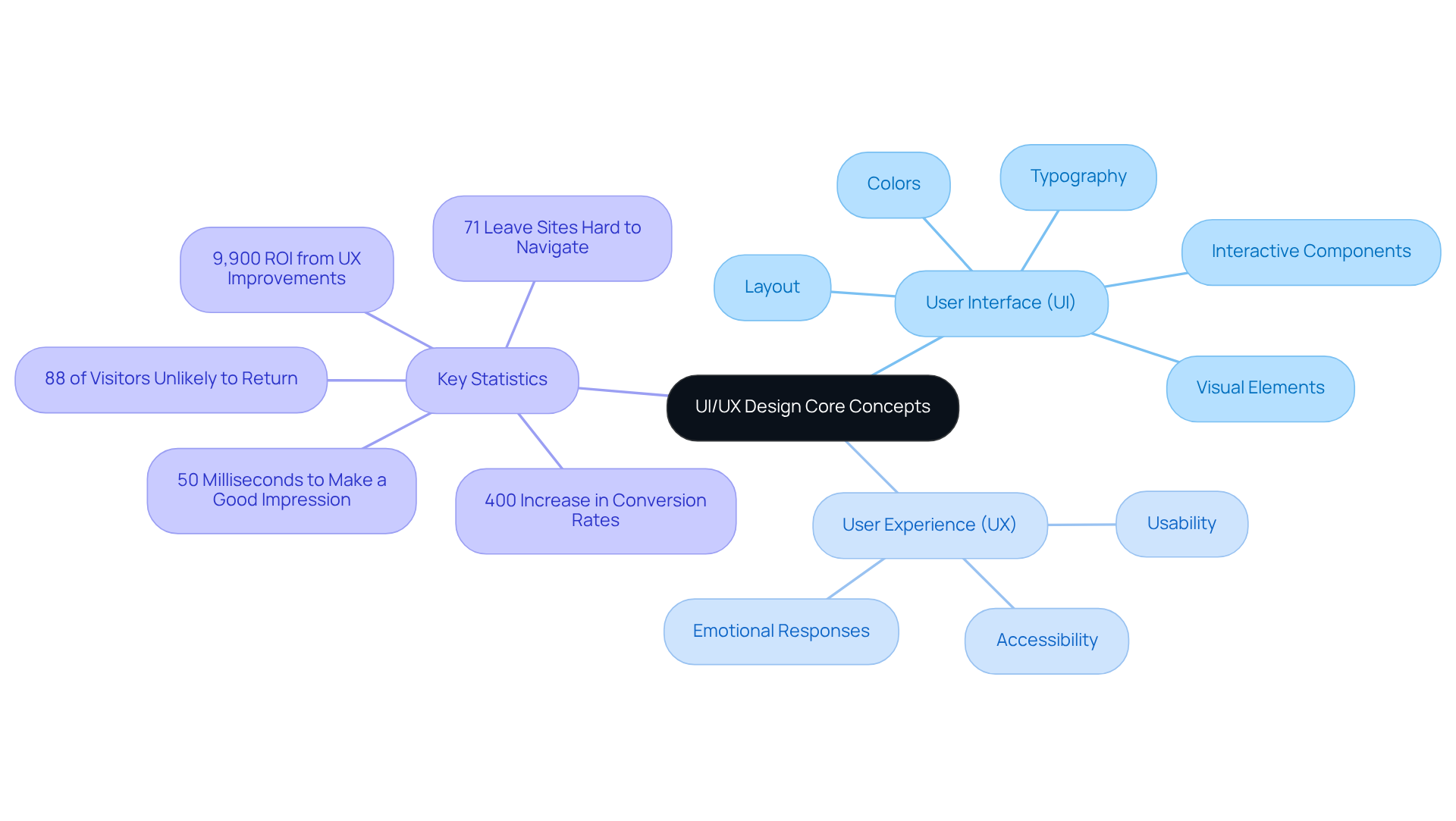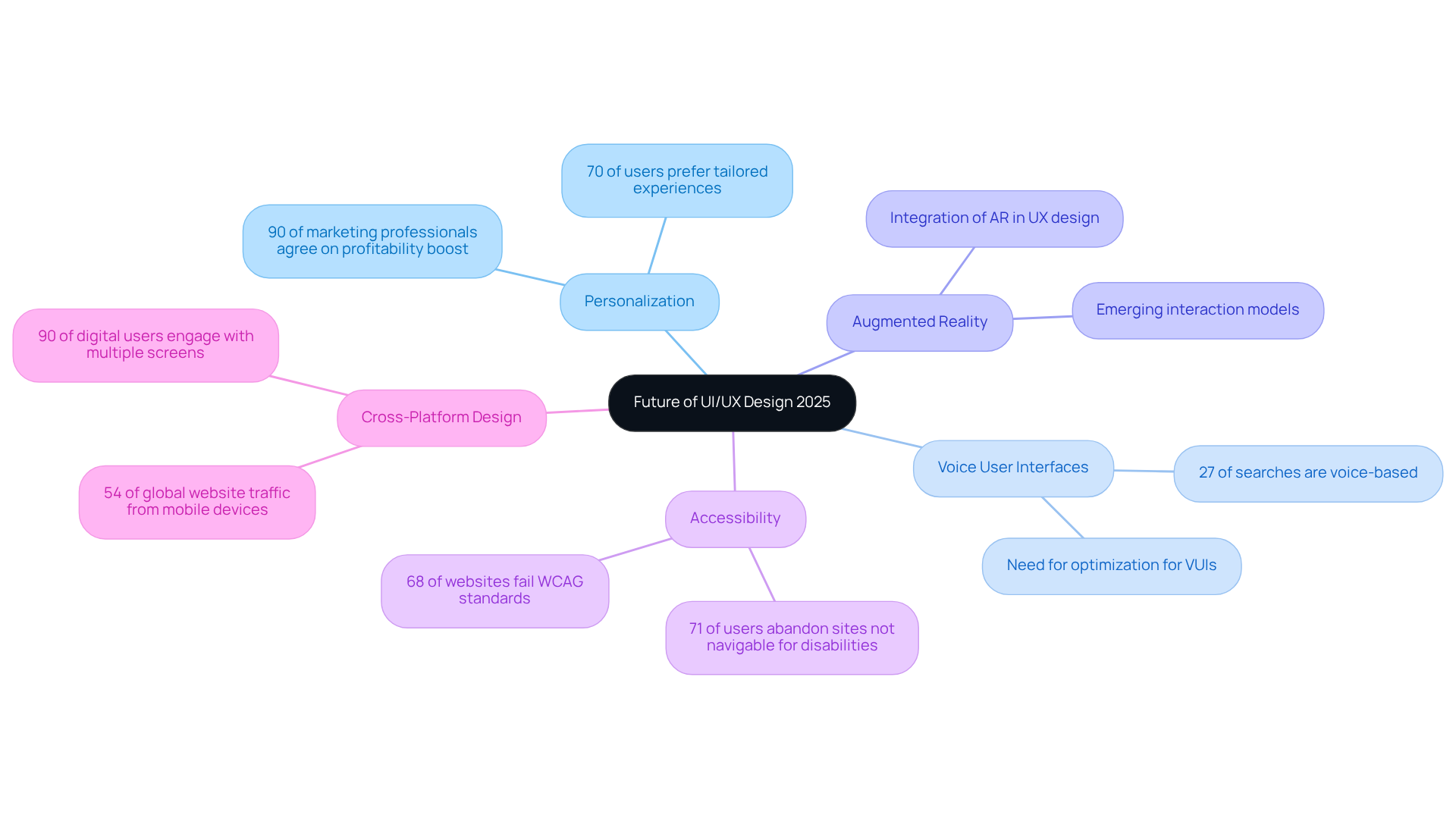Overview
In the fast-paced world of tech startups, many founders grapple with the complexities of UI/UX design. This challenge can often feel overwhelming, as the distinction between UI and UX roles may not be clear. Without effective design, user engagement can suffer, leading to missed opportunities for business success. This is more than just a design issue; it’s about creating meaningful connections with users.
Consider the impact: statistics show that effective design can significantly boost conversion rates and enhance customer satisfaction. Yet, many startups find themselves struggling to keep up with current trends. Emerging concepts like personalization and voice user interfaces are not just buzzwords; they are reshaping the digital landscape and influencing how users interact with products.
At RNO1, we understand these challenges intimately. We believe that embracing these trends and investing in strong UI/UX design is essential for fostering user engagement and driving business growth. Our approach is rooted in empathy, ensuring that we not only address the technical aspects of design but also connect with the emotional needs of users. Together, we can navigate these complexities and create impactful digital experiences that resonate with your audience.
Introduction
In a world where digital experiences shape consumer perceptions, many tech startup founders find themselves grappling with the critical roles of UI and UX designers. These dedicated professionals are not just creators of engaging interfaces; they are essential in crafting seamless interactions that attract users and foster satisfaction and loyalty. However, as the digital landscape evolves, it can be overwhelming to keep pace with the distinct responsibilities of UI and UX designers and the emerging trends that will define their work in 2025. This uncertainty can lead to missed opportunities in an increasingly competitive marketplace.
But there is hope. By understanding and harnessing these insights, businesses can position themselves to thrive. Imagine a future where your digital presence not only captivates users but also builds lasting relationships. This is not just a dream; it’s an achievable goal with the right approach. Let’s explore how you can navigate this journey together, ensuring that your startup not only survives but flourishes in the digital age.
Define UI/UX Design: Core Concepts and Importance
In today’s digital landscape, many startups face a significant challenge: creating engaging and effective products that resonate with their users. The role of a UI/UX designer encompasses the vital fields of User Interface (UI) and User Experience (UX), both essential for addressing this concern. UI creation focuses on the visual elements—layout, colors, typography, and interactive components—ensuring that the interface is not only visually appealing but also user-friendly. Conversely, UX development emphasizes the overall interaction a person has with a product, highlighting usability, accessibility, and the emotional responses that arise during engagements.
The impact of a UI/UX designer on customer satisfaction and conversion rates cannot be overstated. Research indicates that effective UX can lead to an astonishing 400% increase in eCommerce conversion rates. Furthermore, 88% of visitors are unlikely to return to a site that offers a subpar experience. Initial perceptions are crucial; individuals form opinions about a website in just 50 milliseconds, with 94% of first impressions tied to design. This underscores the need for businesses to prioritize the role of a UI/UX designer in their online strategies.
Implementing effective digital strategies that leverage the expertise of a UI/UX designer can significantly enhance engagement and boost conversions. For instance, companies that invest in client satisfaction see an average ROI of 9,900%, translating to nearly $100 for every dollar spent. Additionally, improving mobile user interaction can encourage as many as 74% of visitors to return, illustrating the importance of adaptive layouts in our increasingly mobile-focused world.
RNO1 embodies this commitment through its design-focused solutions, collaborating with brands such as Microsoft and RentMethod to enrich their online experiences. By prioritizing the role of a UI/UX designer, companies can not only elevate customer satisfaction but also cultivate a competitive edge in the digital arena. We invite you to consider how these insights can transform your approach and lead you to success.

Differentiate Between UI and UX Designers: Roles and Responsibilities
UI designers often grapple with the challenge of creating visually appealing and interactive products. They focus on producing layout mockups, selecting color palettes, and ensuring that the interface is user-friendly and attractive. Utilizing design tools like Sketch, Adobe XD, or Figma, they strive to bring their creative visions to life. However, the journey doesn't end there. UX designers delve deeper into understanding individual behaviors and needs through thorough research and testing. This involves:
- Conducting participant interviews
- Developing personas
- Crafting wireframes that map out user journeys
While UI designers emphasize aesthetic appeal, UX designers prioritize functionality, aiming to provide a seamless and enjoyable experience.
Both roles are vital for the success of digital products, and their collaboration is essential in achieving a unified vision. As Emperor Brains wisely notes, "A seamless interface is the silent ambassador of your brand, leaving a lasting impression on every interaction." It's striking to consider that a well-executed UI can enhance conversion rates by up to 200%, whereas an improved UX can lead to conversion increases of up to 400%. This underscores the importance of merging these creative fields to foster greater participant engagement and satisfaction.
Effective collaboration between UI/UX designers not only results in visually appealing products but also ensures that the designs meet user needs and expectations, ultimately driving business success. RNO1's successful partnerships with esteemed brands like Highline and Cirkul showcase how effective UI/UX principles can enhance customer engagement and boost sales. Additionally, RNO1's transformative collaboration with Figure highlights the value of human-centered approaches in reshaping compensation management and improving modern HR platforms. By focusing on these partnerships, RNO1 demonstrates how tailored planning strategies can specifically assist tech startup founders, addressing their unique challenges and enhancing their product offerings.
In today's digital landscape, where mobile internet usage is on the rise, prioritizing mobile optimization is crucial to meet the evolving expectations of users. Together, we can navigate these challenges, ensuring that your product not only stands out visually but also resonates deeply with your audience.
Explore the Future of UI/UX Design: Trends and Skills for 2025
As we approach 2025, many trends are emerging that could significantly reshape UI/UX aesthetics, and it’s essential to recognize the challenges these changes bring. One pressing issue is the growing demand for personalization in digital interactions. With 70% of mobile users preferring applications that offer tailored experiences, the need for customization is evident. This is not just a trend; it’s a crucial aspect of user satisfaction. Moreover, 90% of marketing professionals agree that personalization can greatly boost business profitability, underscoring the importance of effective user experiences.
The rise of voice user interfaces (VUIs) and augmented reality (AR) applications adds another layer of complexity. Designers are now challenged to rethink traditional UI paradigms and explore innovative interaction models. With 27% of searches being conducted through voice, optimizing for VUIs is becoming vital. It’s clear that skills in responsive design, accessibility, and consumer research will be essential as we strive to create inclusive and adaptable digital experiences. In fact, 71% of users abandon websites that are not navigable for individuals with disabilities, highlighting the urgent need for accessibility in development. Additionally, a significant 71% of UX experts believe that AI and machine learning will shape the future of UX, automating design choices and enhancing personalization.
As users increasingly engage with products across various devices, a solid understanding of cross-platform design becomes crucial. With mobile devices accounting for over 54% of global website traffic, ensuring seamless interactions across platforms is essential. For UI/UX designers who aspire to thrive in this rapidly changing digital landscape, staying updated on these trends and continuously refining relevant skills will be key. As Jesse James Garrett wisely notes, "The user experience is not one aspect of the design—it is the design." Embracing this holistic view will not only enhance your work but also foster a deeper connection with users, ultimately leading to more fulfilling and impactful designs.

Conclusion
In today’s fast-paced digital world, many tech startup founders face the challenge of ensuring their products resonate with users. The roles of UI and UX designers are not just about aesthetics; they are vital to enhancing user satisfaction and building lasting relationships with customers. When businesses understand the distinct functions of UI and UX design, they can create engaging, seamless digital experiences that truly connect with users.
This article explores the critical concepts of UI and UX design, underscoring their role in driving customer engagement and boosting conversion rates. For instance, effective design can lead to staggering outcomes, such as a 400% increase in eCommerce conversion rates, highlighting the urgent need for mobile optimization. Furthermore, as we look toward 2025, emerging trends like personalization and voice user interfaces remind us that designers must continually adapt to meet changing user expectations.
As the digital landscape evolves, embracing UI/UX design principles is essential for startups aiming to thrive. It’s not merely about following trends; it’s about recognizing the profound impact that thoughtful design can have on user experiences and overall business success. By prioritizing the roles of UI and UX designers and investing in their expertise, companies can differentiate themselves in a competitive market, ultimately fostering greater customer loyalty and satisfaction.
Remember, you are not alone in this journey. Many startup founders share your concerns, and by supporting one another and valuing the expertise of UI and UX professionals, we can navigate this complex landscape together. Let’s embrace the power of design to create meaningful connections with our users and pave the way for lasting success.
Frequently Asked Questions
What is the difference between UI and UX design?
UI (User Interface) design focuses on the visual elements of a product, such as layout, colors, typography, and interactive components, ensuring the interface is visually appealing and user-friendly. UX (User Experience) design emphasizes the overall interaction a person has with a product, focusing on usability, accessibility, and the emotional responses during engagements.
Why is UI/UX design important for startups?
UI/UX design is crucial for startups as it helps create engaging and effective products that resonate with users. A well-designed UI/UX can lead to higher customer satisfaction and conversion rates, which are essential for the success of any digital product.
How does effective UX impact conversion rates?
Research shows that effective UX can lead to a 400% increase in eCommerce conversion rates, highlighting the significant impact that good design has on customer engagement and sales.
What is the significance of first impressions in UI/UX design?
First impressions are critical; individuals form opinions about a website in just 50 milliseconds, with 94% of first impressions related to design. This emphasizes the need for businesses to prioritize UI/UX design to create positive user experiences from the outset.
What are the potential returns on investment (ROI) for companies that focus on client satisfaction through UI/UX design?
Companies that invest in client satisfaction can see an average ROI of 9,900%, which translates to nearly $100 for every dollar spent. This demonstrates the financial benefits of prioritizing UI/UX design in business strategies.
How can improving mobile user interaction benefit businesses?
Improving mobile user interaction can encourage as many as 74% of visitors to return, highlighting the importance of adaptive layouts in today's mobile-focused digital landscape.
Can you provide examples of companies that prioritize UI/UX design?
RNO1 is an example of a company that prioritizes UI/UX design, collaborating with brands like Microsoft and RentMethod to enhance their online experiences through design-focused solutions.




